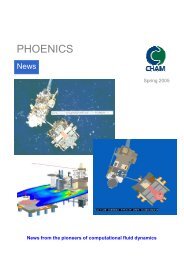PHOENICS - Arcofluid
PHOENICS - Arcofluid
PHOENICS - Arcofluid
You also want an ePaper? Increase the reach of your titles
YUMPU automatically turns print PDFs into web optimized ePapers that Google loves.
<strong>PHOENICS</strong><br />
News<br />
Vascular Profiling at Brigham &<br />
Women’s Hospital, & Harvard Medical<br />
School<br />
Dr Ahmet Umit Coskun, Dr Charles L<br />
Feldman, Northeastern University<br />
The Vascular Profiling Laboratory at Brigham &<br />
Women’s Hospital/Harvard Medical School, under<br />
the direction of Charles L. Feldman, ScD, has used<br />
<strong>PHOENICS</strong> to predict the progression of coronary<br />
atherosclerosis (fatty deposits in the heart’s<br />
arteries) in patients and to explore the mechanisms<br />
of coronary atherosclerosis in swine with artificially<br />
induced diabetes and abnormally high cholesterol.<br />
Dr A U Coskun, the Lab’s Technical Director,<br />
employed a body-fitted coordinate (BFC) mesh to<br />
simulate blood flow through coronary arteries. The<br />
original geometry/anatomy was obtained through a<br />
combination of x-ray and ultrasound images. Flow<br />
rates were obtained by tracking X-ray contrast<br />
(“dye”) through an artery, and patient specific<br />
viscosity was determined from routine blood tests.<br />
The entire process was shown to be highly<br />
reproducible in-vivo [1] . Local sites of low<br />
Endothelial (surface) Shear Stress (ESS) determined<br />
through the simulations agree well with the sites of<br />
coronary artery disease progression [2] .<br />
Animal studies have shown that ESS is<br />
quantitatively related to the clinical significance of<br />
the disease – the lower the ESS the more<br />
dangerous the disease build-up is likely to be [3] .<br />
These results strongly suggest that the use of CFD<br />
to analyze coronary artery flow can lead to a<br />
paradigm shift in patient management and can help<br />
to prevent heart attacks [4] .<br />
Figure illustrates the grid formed at a coarser density than<br />
the one used in simulations for clarity. Body fitted<br />
coordinates available in <strong>PHOENICS</strong> was a natural fit to<br />
the complex coronary artery geometries with the disease.<br />
The geometry is from a right coronary artery indicated by<br />
the arrows in the x-ray angiogram.<br />
Summer 2008<br />
Figure shows a time snapshot of the velocity<br />
profile at a cross-section and the surface shear<br />
stress distribution at two different angles (front<br />
and back with respect to the grid). Local<br />
variations of shear stress due to curvature and/or<br />
surface irregularities are apparent and known to<br />
correlate with progression of coronary artery<br />
disease.<br />
1. Coskun, A.U., et al., “Reproducibility of<br />
coronary lumen, plaque, and vessel wall<br />
reconstruction and of endothelial shear stress<br />
measurements in-vivo in humans,”<br />
Catheterization and Cardiovascular<br />
Interventions, 60: 67-78, 2003.<br />
2. Stone, P.H., et al., “Effect of endothelial<br />
shear stress on the progression of coronary<br />
artery disease, vascular remodeling, and instent<br />
restenosis in humans: In-vivo 6-month<br />
follow-up study,” Circulation, 108:438-444,<br />
2003.<br />
3. Chatzizisis Y. S., et al., “Prediction of the<br />
Localization of High-Risk Coronary<br />
Atherosclerotic Plaques on the Basis of Low<br />
Endothelial Shear Stress: An Intravascular<br />
Ultrasound and Histopathology Natural<br />
History Study,” Circulation, 117:993-1002,<br />
2008.<br />
4. Chatzizisis, Y.S., et al, “Risk Stratification of<br />
Individual Coronary Lesions Using Local<br />
Endothelial Shear Stress: A New Paradigm<br />
for Managing Coronary Artery Disease,”<br />
Current Opinion in Cardiology, 28:552-564,<br />
2007.<br />
Dr. Ahmet Umit COSKUN<br />
Associate Research Engineer<br />
E-Mail: acoskun@coe.neu.edu<br />
News from the pioneers of computational fluid dynamics 8








